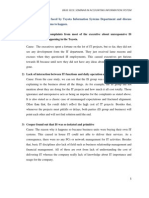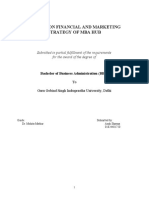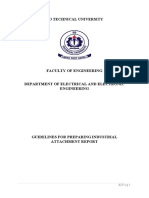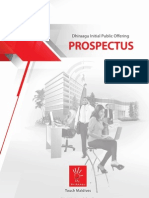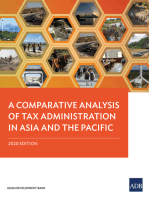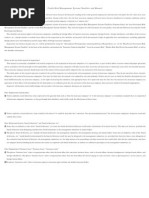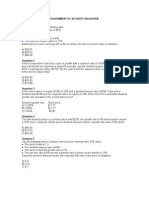Accounting 12 Course Outline
Uploaded by
Kenrose LaguyoAccounting 12 Course Outline
Uploaded by
Kenrose LaguyoRepublic of the Philippines
CARLOS HILADO MEMORIAL STATE COLLEGE
Fortune Towne Campus, Bacolod City, Negros Occidental
COURSE OUTLINE
in
ACCOUNTING 12
Course Number
ADVANCE COMPUTER APPLICATION FOR ACCOUNTANTS
Descriptive Title
First Semester, Academic Year 2017-2018
Semester/Academic Year
Prepared by:
KENROSE SOLOMON LAGUYO, CPA, MBA
Subject Teacher
I. Course Description
Advance computer application for accountants introduces students to the systems that underlie bookkeeping,
accounting, and financial reporting in all business firms. Such systems are increasingly complex and in
continual state of flux due to rapidly changing technologies and securities risks. In this course, the students
gain hands-on experience in, the use of electronic spreadsheet software for advanced business analysis and
hands-on experience with a commercial accounting software package.
II. Course Learning Outcomes
Upon completion of this course, the students can:
1. Create or set-up a company in QuickBooks.
2. Set-up chart of accounts and the corresponding beginning balances.
3. Set-up customers and vendors and the corresponding account balances.
4. Set-up items and inventory stock card balances.
5. Prepare purchase orders, receive inventory, paybills, and pay vendors.
6. Prepare sales invoice, record cash receipts and payment from customers.
7. Prepare managerial reports such as inventory valuation, bank reconciliation statement, aging of
accounts receivable and payable, etc.
8. Prepare financial report such as profit and loss, balance sheet, statement of cash flow, etc.
III. Course Requirements
1. Quizzes
2. Attendance
3. Class Participation
4. Examinations
5. Project
IV. Academic Performance Evaluation System
A. Performance (80%)
1. Knowledge
a. Quizzes / Unit Tests 30%
b. Mid-term / End-term Examinations 20%
c. Participation in class deliberations 10%
2. Skills 10%
a. Graded Discussion / Extemporaneous Discussion
3. Attitude / Attendance 10%
a. Attendance/Regularity/Promptness
b. Involvement / Commitment
c. Attitude / Conduct
B. Requirement/Project/Output - 20%
a. Term Paper / Project / Portfolio ___
T O T A L .... 100%
V. Reference
1. Computer Accounting Essentials with QuickBooks 2014, 7th Ed. 2015, Carol Yacht & Susan V.
Crosson, McGraw-Hill Education, USA
2. Using QuickBooks Accountant for Accounting 2013, Glen Owen, Cengage Learning Asia Pte.Ltd.
VI. Course Contents
STUDENT
COURSE CONTENTS/TOPICS INTENDED LEARNING OUTCOMES
ACTIVITIES
Orientation 1. Discuss the VMGO of the 1. Research
The VMGO of the institution institution and those of the Discuss
BSACT.
The Course and its role in attaining
the VMGO 2. Relate the role of the course in
the attainment of the
Principles of Accountancy and GAD institutional VMGO and the
department goals & Objectives.
3. Relate the course to the ideals of
gender and development issue.
1. Introduction to QuickBooks At the end of the topic the
1.1 Principles of accounting students should be able to: - Research
1.2 QuickBooks System 1. Discuss the principles of - Reporting
1.2.1 What accounting does accounting
1.2.2 What QuickBooks does 2. Discuss what accounting and
1.2.3 Development of QuickBooks QuickBooks does
1.2.4 Overview of QuickBooks 3. Enumerate the documents
prepared by QuickBooks
2. Creating a New Company 1. Create a new company in
2.1 Create a new company QuickBooks Computer
2.2 Backing up Company Data 2. Back-up data in the flash drive laboratory
3. Create the graphical user
interface of QuickBooks
3. New Company Setup for Merchandising
Business 1. Set preferences for the new Computer
3.1 Set preferences company laboratory
3.2 Edit the chart of accounts and enter 2. Edit the chart of accounts and
beginning balances. edit to correct an error.
3.3 Record check register entries. 3. Display trial balance and
3.4 Edit to correct and error. financial statements
3.5 Compete account reconciliation.
3.6 Display trial balance
3.7 Display the trial balance
3.8 Display the financial statements
4. Account Register
4.1 Make deposit
STUDENT
COURSE CONTENTS/TOPICS INTENDED LEARNING OUTCOMES
ACTIVITIES
4.2 Write checks for assets and dividends 1. Deposit collections in Computer
4.3 Add new vendor QuickBooks laboratory
4.4 Bank account register 2. Write checks for assets and
4.5 Edit an erroneous entry dividends as well as correct the
4.5 Bank reconciliation erroneous entry.
3. Prepare monthly bank
reconciliation.
5. General Ledger, Trial Balance, and
Financial Statements 1. Process transaction detail by Computer
5.1 Transaction detail by account account. laboratory
5.2 Trial Balance 2. Process trial balance
5.3 Financial Statements 3. Process financial statements
Long quiz
6. Working with Inventory, Vendor and
Customers - Add a vendor and customer Computer
6.1 Enter items and inventory records laboratory
preferences - Add inventory and non-
6.2 Enter vendor records inventory items
6.3 Enter inventory items - Paybills and and vendors
6.4 Enter bills and record purchase account
returns - Record purchase returns
6.5 Paybills - Enter customer records and
6.6 Add a vendor and non-inventory item accounts
6.6 Enter customer records and defaults - Record cash sales, sales on
6.7 Record customer sales on account account and sales returns
and sales returns - Record collection
6.8 Receive customer payments
Midterm Exam
7. Practice Set
7.1 Create a new company - Application of what has been Computer
7.2 Set-up chart of accounts and the discussed, and demonstrated in laboratory
corresponding beginning balances the previous lesson.
7.3 Set vendors and customers list with - The student should be able to
the corresponding balances create a new company, record
7.4 Set up inventory and non-inventory all the transactions and
items with corresponding balances generate monthly report
7.5 Record the transactions for 1 month
7.6 Generate and prepare reports such
as: trial balance, profit and loss,
statement of cash flow, AR aging, AP
aging, transaction list by date, and
audit trail
Final Exam
Prepared by:
PROF. KENROSE S. LAGUYO, CPA, MBA
You might also like
- Leadership Complexity and Change - Mandhu CollegeNo ratings yetLeadership Complexity and Change - Mandhu College13 pages
- Managing and Using Information Systems: A Strategic Approach - Seventh EditionNo ratings yetManaging and Using Information Systems: A Strategic Approach - Seventh Edition25 pages
- Case Study 6 - Schneider National Keeps On Trucking With Communications Technology100% (1)Case Study 6 - Schneider National Keeps On Trucking With Communications Technology3 pages
- A Case Study of Netflix's Entry Into KoreaNo ratings yetA Case Study of Netflix's Entry Into Korea13 pages
- 10 Decision Areas of Operations Management: Google 'S Human Resource ManagementNo ratings yet10 Decision Areas of Operations Management: Google 'S Human Resource Management2 pages
- Chapter 4 and 5: Responsibility CentersNo ratings yetChapter 4 and 5: Responsibility Centers30 pages
- To Study On Financial Functions of Benco OilNo ratings yetTo Study On Financial Functions of Benco Oil15 pages
- Chapter 6: Introduction To Capital BudgetingNo ratings yetChapter 6: Introduction To Capital Budgeting3 pages
- Introduction To Entrepreneurship, 8e Donald F. Kuratko: Entrepreneurial Ventures & The Business PlanNo ratings yetIntroduction To Entrepreneurship, 8e Donald F. Kuratko: Entrepreneurial Ventures & The Business Plan25 pages
- Case Study Industry and Competitor AnalysisNo ratings yetCase Study Industry and Competitor Analysis4 pages
- Technology Analysis & Strategic ManagementNo ratings yetTechnology Analysis & Strategic Management15 pages
- Industrial Attachment Report Guide For BTech (HTU EEE) - FINALNo ratings yetIndustrial Attachment Report Guide For BTech (HTU EEE) - FINAL7 pages
- Job Description - Financial Controller: OverviewNo ratings yetJob Description - Financial Controller: Overview6 pages
- Human Resource Management, 15e Joseph MartocchioNo ratings yetHuman Resource Management, 15e Joseph Martocchio62 pages
- Software Development Manager 2005 Job DescriptionNo ratings yetSoftware Development Manager 2005 Job Description2 pages
- Disadvantages of Management Information SystemNo ratings yetDisadvantages of Management Information System2 pages
- Chapter One Financial and Managerial AccountingNo ratings yetChapter One Financial and Managerial Accounting52 pages
- Electronic Data Processing: Advantages of Using EDPNo ratings yetElectronic Data Processing: Advantages of Using EDP24 pages
- Reference Book: "Enterprise Systems For Management": Development Life CycleNo ratings yetReference Book: "Enterprise Systems For Management": Development Life Cycle31 pages
- Instant download Reinventing ITIL® in the Age of DevOps: Innovative Techniques to Make Processes Agile and Relevant 1st Edition Abhinav Krishna Kaiser pdf all chapter100% (1)Instant download Reinventing ITIL® in the Age of DevOps: Innovative Techniques to Make Processes Agile and Relevant 1st Edition Abhinav Krishna Kaiser pdf all chapter55 pages
- Next Job Inc Provides Employment Consulting Services The Company Adjusts100% (1)Next Job Inc Provides Employment Consulting Services The Company Adjusts2 pages
- A Comparative Analysis of Tax Administration in Asia and the Pacific: 2020 EditionFrom EverandA Comparative Analysis of Tax Administration in Asia and the Pacific: 2020 EditionNo ratings yet
- Energy, Oil, Gas & Mining: Honourable Mention - Carol Natukunda & Robert Atuhairwe, New VisionNo ratings yetEnergy, Oil, Gas & Mining: Honourable Mention - Carol Natukunda & Robert Atuhairwe, New Vision2 pages
- Performance Measurement in Decentralized OrganizationsNo ratings yetPerformance Measurement in Decentralized Organizations56 pages
- Consolidations - Subsequent To The Date of AcquisitionNo ratings yetConsolidations - Subsequent To The Date of Acquisition42 pages
- Synopsis Capital Budgeting Reddy's LabshjklhjlNo ratings yetSynopsis Capital Budgeting Reddy's Labshjklhjl10 pages
- Project - Financial Apprasial of ITI LTDNo ratings yetProject - Financial Apprasial of ITI LTD67 pages
- Efg Financial Products LTD Brandschenkestrasse 90, Ch-8002No ratings yetEfg Financial Products LTD Brandschenkestrasse 90, Ch-80023 pages



